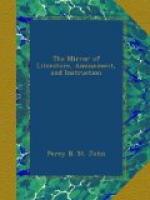The following interesting particulars, relating to the capability of the ostrich to digest hard substances, is given by Mr. Fuller, in his Tour of the Turkish Empire:—“An ostrich, belonging to an English gentleman, arrived at Cairo from Upper Egypt, and afforded us an opportunity of observing this curious peculiarity in the natural history of that animal. The persons in charge of him observing his great propensity for hard substances, mistook, unfortunately, for his natural and ordinary diet, things that were only the objects of his luxury; and while they gave him corn only occasionally, administered every day a certain portion of iron, chiefly in the form of nails, to which he occasionally added a knife or a razor, which he chanced to pick up, or a few loose buttons, which he pulled from the coats of his attendants. This metallic system did not however succeed; the poor bird drooped gradually, his strength just lasted him to walk with a stately step into the court of the Consulate, and he died in about an hour afterwards. On a post mortem examination, at which I was present, about three pounds of iron were taken from his stomach. A considerable portion of the hardest parts, such as the blades of the knives and razor, was dissolved; and it is possible that the whole might in time have been digested, as the death of the animal was in part accidental, being immediately occasioned by a sharp boat-builder’s nail, three or four inches long, which he had swallowed, and which had penetrated quite through the stomach, and produced mortification.”
W.G.C.
* * * * *
EFFECTS OF LIGHT AND AIR ON PLANTS.
The importance of light and air to plants is well known. When unassisted by these agents, plants lose their colour, and are deprived of many of their properties. Colour is thus evidently produced by the absorption of carbonic acid gas: and the colouring matter may be detected by a powerful microscope, lodged in the cellular substance of the leaf. How this colour is formed, and why it assumes different tints in different plants, are, however, questions which it is at present impossible to decide. The secretions of plants depend upon light, and their flavour and nutritious qualities are materially altered by their exclusion from it. The importance of this knowledge to a practical horticulturist is proved by the fact, that sea-kale, so well known as a wholesome and palatable vegetable, is not eatable in its original state; and that any part of the cultivated plant, if accidentally left exposed to the action of the air and light, becomes tough, and so strong in flavour as to be extremely unpleasant to the taste. Celery, also, in its native state, is poisonous; and it is only the parts that are blanched that are perfectly fitted for the table. Though colour is generally supposed to depend principally on the plant’s being exposed to the light, some portion of colouring




